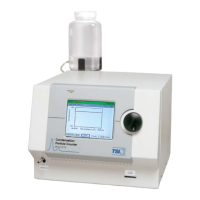8-16 Model 3775 Condensation Particle Counter
Inlet flow in the high flow mode may be reduced if the bypass filter
is loaded. The bypass filter is shown in
Figure 8-2. Prior to
adjusting the bypass/makeup air variable orifice, replace the
bypass filter. To adjust the bypass/makeup air flow, perform the
following operations.
Caution
Whenever performing service on internal components avoid damage to the UCPC
circuitry by not stressing internal wiring, through bumping, snagging, or pulling.
Also use electrostatic discharge (ESD) precautions:
Use only a table top with a grounded conducting surface.
Wear a grounded, static-discharging wrist strap.
WARNING
Procedures described below require removal of the instrument cover with the
instrument powered. Keep hands away from electronic components to avoid
possible electrical shock hazard.
1. Read warnings and cautions at the beginning of this chapter.
2. Unplug the instrument and remove the instrument cover by
loosening the six side panel screws (they don’t have to be fully
removed). Lift the cover up. Do not remove the screws holding
the clear butanol reservoir cover.
3. With the cover removed, locate the small bypass/makeup
variable orifice, item number 10 in
Figure 3-5. This orifice has a
screw adjustment for a flat blade screwdriver.
4. Remove the bulk of the red material used to prevent the screw
on the variable orifice from turning due to vibration.
5. Because the instrument is powered, pay special attention to the
caution and warning above.
6. Using a flat blade screwdriver, adjust the orifice screw while
monitoring the flow using your flowmeter.
7. Adjust the flow to the desired value.
Maintenance of the Critical Orifice
If the differential pressure across the Nozzle decreases significantly
from its initial value, an aerosol flow error is indicated on the front
panel display, meaning a possible contaminated or plugged critical
orifice (see note next page). The initial value of nozzle pressure is
found on the checkout data sheet supplied with the instrument.
Current nozzle differential and crifical orifice differential pressure
are both displayed on the Status screen shown in
Figure 4-9,
Chapter 4. Note that the orifice differential pressure can indicate

